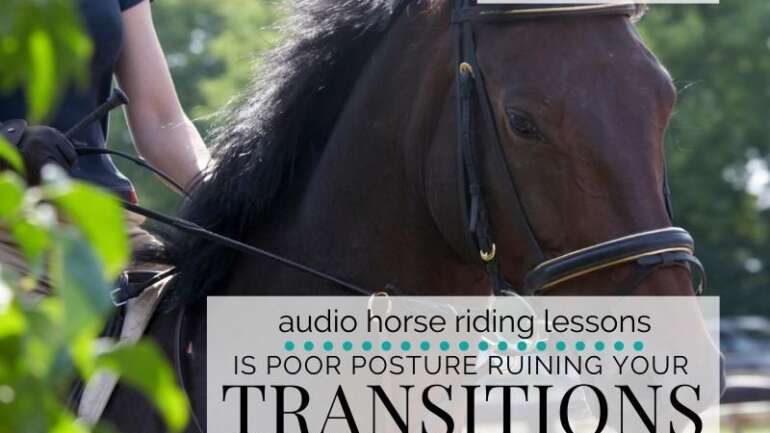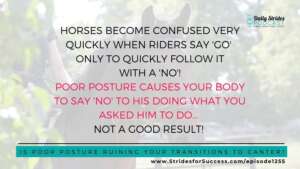The transition into canter is one that always gives us opportunities to develop and improve as riders. And it can do the same for our horses as well. And yet, for many riders, improvement is frustratingly slow! The good news is that it doesn’t have to be this way.
Canter and transitions into the canter are one aspect of horse riding that can improve quickly, often with just the smallest of tweaks applied.
The key is to be strategic about what you are tweaking. And be willing to look out for the effect it has on yourself, your horse, and the transition in general. One of the simplest ‘tweaks’ you can apply is around improving your posture when you ride. By simply ‘sitting differently’ you can transform the transition for the better.
Self-Carriage as a Rider
Self-carriage is a big topic when it comes to horse riding. It’s something we are always trying to cultivate and improve in our horses. And rightly so, as when your horse develops both the understanding and the ability to carry himself a little better, it opens doors to so many new opportunities for you both to work together.
I think that if you are asking your horse to carry you, and he obliges. Well, the least we can do as a rider is to take responsibility for making that as easy as possible for him to do. Carry ourselves.
Unfortunately, terms like ‘shoulders back’ have been shouted for so long to so many riders, that true self-carriage has become a little, well, confused in our heads! Rather than thinking about ‘shoulders back’, I suggest visualizing ‘opening your chest’. So from the point of your one shoulder across the front of your chest to the point of your other shoulder. Open this space up.
Couple this with the feeling of creating ‘space’ between your ribs and your hips. Elongating your body. This is self-carriage (and engagement) through your body as a rider and it will help your transitions to canter.
Poor Posture & Its Results…
When you are in true self-carriage, coordinating and using. your aids become so much easier. Meaning when we are heavy, slouched, and too relaxed (not enough engagement or tension) through our bodies, things can become muddled up very quickly!
Your body becomes harder to move. Some aids are impossible to move independently. And you can no longer move with the energy your horse is creating.
When riding, especially transitions to canter, you are either working with the energy or working against it. If your horse, because he is the kind soul that he is, does actually canter when you ‘ask’ we need to be in self-carriage. When we are not, by blocking this energy, you are telling your horse that his response to your ‘ask’ for the canter was the wrong one!
Horses become confused very quickly when riders say ‘go’ only to quickly follow it with a ‘no’! Poor posture causes your body to say ‘no’ to his doing what you asked him to do… Not a good result!
Lack of Independence
The other downside to poor posture, especially as you ask for transitions to canter is your lack of independence. This means that you are dependent on either your other aids for balance or support. Or your horse. Either way, it will cause issues as your horse moves from the walk or the trot into the canter.
If you are using your hands to balance in the saddle, this will make true contact impossible. As well as stop the forward flow of energy your horse needs when performing transitions to canter.
If you are dependent on your horse for support and balance, the upward energy created through transitions to canter will throw you off balance. Both of these situations will cause both the transition and the canter that happens afterward to become tense for the horse and rider.
Relaxation is the foundation of everything when riding. Creating excess tension due to a lack of independence through seat and aids will ruin your transitions to canter.
Light Transitions to Canter
Begin by modeling, through your body, what you want your horse to do. In the transitions to canter focus on carrying yourself. By doing this you will both communicate with clearer aids and create the space and balance necessary for the transition to happen.
The transitions to canter are ‘upward’. They feel like a step up into the new gait. If we block that upward movement of the energy, our horses cannot respond as we would like them to.
As your horse ‘steps up’ into the canter, allow your seat to follow first. Then your hands, and finally the rest of your body. Work on strengthening the connection between your seat and your hands. Whatever your seat does through the transition, and in the canter itself, let your hands do the same.
By practicing this consistently and preparing your transitions to canter beforehand, you will find that you will not only have a better transition. But you will also your canter will improve as well.
Happy Riding
Lorna
Improve Your Canter
Improve Your Canter is a 4-week program you can use to help develop both you and your horse in the canter. It is suitable for riders working alone without a trainer or coach. In there you will learn what is happening underneath you and why. You will also put this into practice using audio horse riding lessons. tailored for each day of the program, with your horse.


